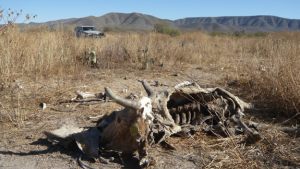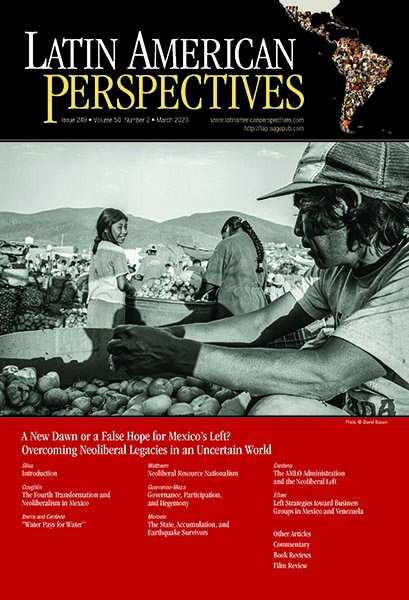 Review by: Tomás Crowder-Taraborrelli
Review by: Tomás Crowder-Taraborrelli
Approaches to telling a story are, of course, abundant. Latin American filmmakers borrow from all kinds of artistic traditions—literature, pop music, the plastic arts, home movies, etc. What makes this borrowing both draining and stimulating is that the web offers an excess of examples to draw from. Further, digital production and online distribution are cultivating a new kinship among filmmakers, visual traditions, and viewers across the world. This is a daunting realization that the current crop of young filmmakers is trying to grapple with. Two recent documentary films from Mexico and Argentina bring the topic of social and cultural migration into focus, giving international audiences the opportunity to enter otherwise inaccessible worlds. Cuates de Australia (Drought) from Mexico and La chica del sur (The Girl from the South) from Argentina display contrasting approaches to portraying the hardships of relocation.
Both documentaries follow their protagonists’ journeys from the place they call home to an unfamiliar land and their bittersweet return. Cuates de Australia, directed by Everardo González, is an enigmatic film. It goes out of its way to remain removed from its subject, but it cannot help but become enamored of its own rendition of it. This essential quality works in the film’s favor, since it creates sequences of great tenderness and anguish. It was filmed in the Sierra de Coahuila, Mexico, in the ejido known as Cuates de Australia. This is a region of dusty hills, with a cluster of adobe houses (Figure 1). The sandy roads are strewn with abandoned truck tires. Coyotes and snakes roam in search of prey. Dust forms abstract sketches on the windows, and children strain to see the clouds through these designs. The settlement, like the ones in edgy American Westerns such as Martin Ritt’s Hud (1963), feels atemporal.
Its color palette is sepia, and this helps give the cinematography its magnetism. There are few things more visually striking than men riding horses and lassoing cattle in a cloud of dust. Vigor, readiness, integrity, and determination give rural labor a certain glamour. When asked, people are unable to explain why their ranch is named “Cuates de Australia.” It is a fitting name for the film, though, because it reminds us of the lunar landscapes of central Australia and the menacing news stories about rising temperatures and droughts in that country. A candid scene, full of innocence and foreboding, reveals that the children cannot find their town on a map. Where is this place? Why should audiences care about these people? Should we see them as representing a destiny that awaits us all? If the drought that creeps through the landscape, eating all life away, reaches us, will we be able to leave our homes and find shelter? Or are we all going to drop dead on a dusty road?
In the beginning it is not clear what González’s documentary is about. The roughness of the place contrasts with a collection of dynamic vignettes of the rancheros’ way of life. The film evokes the glamour of Hollywood cowboys, but it has no good guys or bad guys. Shots of the vast landscape have the existential angst and imminent violence of Glauber Rocha’s cangaceiros tragedies, such as Black God, White Devil (1964), or Nelson Pereira dos Santos’s Vidas secas (1963). The storm clouds gather on the horizon. Thunder can be heard. It is raining somewhere beyond these dusty hills. Cuates de Australia is easily categorized as an observational documentary, adopting a mode of representation commonly referred to as the “fly-on-the-wall” approach. The audience cannot see the film crew, there is no voice-over, and the takes are long and contemplative. González chose not to include lengthy interviews, giving audiences the freedom to immerse themselves in the life of the town. Although we are compelled to figure out how all the sequences add up to a form of social criticism, the documentary’s narrative authority is established by the beauty of the cinematography and the subtlety of the editing. To be sure, some audiences will be left feeling that they have not learned enough about these people, particularly since we cannot hear their grievances, but it is refreshing not to have a lot of talking heads dominating the exposition.
Some of what we learn about this rural community comes from a survey conducted by a census field representative. The contrast between the questionnaire and their humble living conditions gives this sequence a sinister humor. Do they have a car? No. How many hours do they work? All day. González’s camera, compassionately voyeuristic, takes us inside their homes. They have no televisions, no home radios. To listen to music, they open their truck doors and blast their car stereos. In this day and age, when urban dwellers are beginning to recognize that city life is not what it was cracked up to be, given ballooning mortgages, air pollution, horrendous traffic, and an overproduction of rudeness, rural life can seem like a Rousseauistic haven.
Water is at the center of this community’s life. There is no running water, and families have to transport it in plastic tanks from a nearly exhausted water reserve. Some explain the absence of rain as a manifestation of God’s design. Still, the atmosphere of the documentary asks when it is going to come to refresh the cattle, settle the dust, and allay the people’s growing discontent. We are left wondering if relief will come to this community. The last minutes of the documentary are ominous and come close to having the moral authority of Buñuel’s Las Hurdes (Land without Bread) (1933). A horse and a foal stumble like two drunkards down a road. The foal drops dead. The people, recognizing this warning sign, get into their rusty trucks and leave like a band of runaways. They carry with them their horses, chickens, and dogs; all other feeble animals are left to die. Only predators will survive the drought.
Finally, the rain comes. The people return with their chickens, dogs, children, and melancholy songs. González leaves us to answer yet another question: Why do they return to this inhospitable land? It is uncertain whether a better option would be to move to a urban area and scramble to find a low-paying job along with many other laborers in Latin American cities. At least at the ranch they get to do what they have always done—hard physical work at the foot of the solemn hills. The drought sent them away, but the rain welcomed them back—back to their land, at least for now.
La chica del sur, recipient of the Audience Award at the 2012 Buenos Aires Festival Internacional de Cine Independiente, is a film that stays with you for days. It is directed by José Luis García, who made the documentary Cándido López: Los campos de batalla (2005)—an engrossing film about the convergence of López’s oil paintings of battles during the War of the Triple Alliance with García’s rather disturbing findings at the reported sites of those bloody battles. His new work clearly demonstrates that he is a talented filmmaker, not only a good storyteller but also a conjurer of haunting images.
In the summer of 1989, just a few months before the Berlin Wall began to be chipped away and three weeks after the killings in Tiananmen Square, García’s brother received funding from the Soviet Union to travel with an Argentine delegation to a youth festival for left-wing activists in North Korea. Shortly before the festival the brother backed out, and García, 24 years old at the time and suffering the humiliation of having been recently dumped by his girlfriend, bought the travel package for $500. Like most Argentine youth at the time, he knew very little about North Korea. The landing of the Argentine delegation in Pyongyang coincided with the arrival of the South Korean political activist Lim Sukyung, who, because of travel restrictions, had arrived at the youth festival via Tokyo, Berlin, and Moscow. García filmed the Beatles-esque reception that North Koreans held for this charismatic girl (Figure 2).
Audiences will thank García for having decided to take a VHS camera (on loan from a friend) on his trip and for safeguarding the footage from the turmoil of more than 10 moves in different countries over two decades. The VHS sequences of the youth festival, Sukyung’s cries for unification at rallies (featured in the first 25 minutes of the documentary), and the hurried efforts of the Argentine students to figure out ways to engage with other delegations are surprisingly vibrant, with hint of nostalgia and the hurried quality of crisis-news coverage. The battle cries of the young left-wing activists captured by García’s video camera include slogans such as “For Anti-Imperialism Solidarity,” “Cancel All Foreign Debt of Poor Countries,” and “British Out of the Malvinas.” Treaties are signed, speeches banged out on typewriters in smoky rooms, and rallies organized, and late at night the visiting student delegations dance to a perestroika tune set to a disco beat. Axel Krygier provides an eerie soundtrack and the melancholy piano musings that haunt the opening scene. Surprisingly, in the voiceover, García tells us that only the Scandinavian delegations dared to discuss the recent massacre in China.
There is something magical about Sukyung’s presence as she fights the welcoming crowds (the film tells us that she hurt her wrists in shaking hundreds of hands). Sukyung has an elusive noir-like glamour; despite the charming smile she wears, she seems to be withholding government secrets. She is remarkably at ease in front of the dozens of TV cameras, reel-to-reel tape recorders, and microphones that surround her. García follows her with his camera (an accidental paparazzo among dozens of others) and finally gets close to her when he sneaks into a press conference. Sukyung speaks gracefully of the ways of reaching lasting peace between the neighboring nations: “We are one people, one nation, and so we must achieve reunification.” She calls for the withdrawal of U.S. troops and pledges—“Even if I die”—to go back to South Korea through Panmunjom, a minefield 4 kilometers wide between North and South Korea. She hopes that she will be remembered as “the flower of reunification.”
García’s approach is in sharp contrast to González’s. There is no attempt here to remain “a fly on the wall.” The director dominates the narrative with his biting tone, gradually infecting audiences with his infatuation with this rising political personality. There is an element of self-parody in his portrayal of himself as a shyer version of Nick Broomfield (Kurt & Courtney, 1998) and less intellectual than Dennis O’Rourke (The Good Woman of Bangkok, 1991). His narrative voice is that of a filmmaker apparently made uneasy by his own desire to pry. He avoids being filmed, although his silhouette sneaks in and out of the corners of the frame. One would think that La chica del sur would lose its fascination when García’s trip comes to an end, but this is not the case. Upon his return to Buenos Aires, he finds out that Sukyung did in fact manage to cross the border, accompanied by a priest. She was immediately detained in South Korea for infringement upon national security and sentenced to a ten-year prison term (of which she served two years and a few months). Years later, García, wanting to use the footage he shot on his first visit to North Korea, decided to look Sukyung up online. After a few attempts she agreed to be interviewed and welcomed the director and his crew to Korea. “It was like a message in a bottle,” he says in the film. Sukyung had had a son, but he had died in a pool accident when he was eight. García tells us that the right-wing newspapers gloated over the death of “the communist’s” son. To find solace after the boy’s death and her subsequent divorce, she entered a Buddhist monastery in the mountains, where she stayed for three years. A great deal of the film chronicles García’s frequent attempts to interview the celebrity, now a professor of mass communications at Hankuk University and the host of a radio show called One Korea. Despite her professional demeanor, Sukyung turns out to be a very elusive subject for García, using her friends and the director’s translator (the historian Alejandro Kim) as a means to end disagreeable interrogations about Korean politics and the prospects for reunification. García hovers around his subject at the university, at the radio station, in numerous bars, and in her parents’ home, which is outfitted as a shrine to her glorious dissident past with statuettes, oil paintings, diplomas, framed photographs of her arrest, scrapbooks holding newspaper articles, etc. On the occasion of his visit his subject stays in the kitchen, reprimanding her mother for chatting too much with the guests, reminding her “You’re not even going to see these people ever again.” It seems that this oddly assorted cast often ends up in a bar, where Sukyung is easily recognized. Sukyung is brash and gracefully melancholy, and she has not lost her youthful charm and wit in front of the camera: “I don’t have an ideology,” she says. “I want to help those who suffer. . . . I want to confront those who have power.” When the conversation gets thorny, she interrupts her questioner and yells, “Let’s drink!” García and Kim eventually return to Argentina, leaving the audience potentially frustrated that the director was unable to carry out a memorable interview with or elicit a confession from his star. Surprisingly, however, or perhaps inevitably, Sukyung springs up in Buenos Aires, walking the streets of Flores (the Korean neighborhood) chaperoned by Kim. She finally agrees to sit down with García and submit to his interrogation. “Is this a formal interview?” she demands. He hesitates. The comedy of errors continues as Sukyung, Kim, and García change chairs around a table, exchanging querying glances, grievances, and puzzlement. Finally, García asks his first question: Will South Korea and North Korea ever find common ground, or will South Korea feast on its neighbor? Needless to say, things do not go well. At the end of the film, the three travel to Ushuaia, Argentina’s southernmost city, a stone’s throw from the South Pole. García is able to share with his audience that one of Sukyung’s few intimate disclosures comes from a magazine article she wrote during her stay in the monastery, in which she says that her way of coping with her son’s death is to find him everywhere. Preparing for the trip to the Philippines on which he drowned, the boy had chosen a favorite book to carry in his backpack—a survival manual for the South Pole. In Ushuaia, Sukyung seems happy, at peace, as if this trip assured her once again that, as García repeatedly suggests in the film, geography keeps us forever united even if we live in the antipodes.
Regardless of their different approaches to storytelling, La chica del sur and Cuates de Australiaacknowledge that capturing social reality on film is not easy. Its complexities can be rendered only through the artifice of narration and the poetics of representation.



